Larry Lawrence | November 13, 2022
Cycle News Archives
COLUMN
The First AMA Pro Motocross Event
LaRue, Ohio, a small farming village about 60 miles northwest of Columbus, established in 1851 along the banks of the Scioto River, with a population today of 747 people. It might be considered a one stop-light town save for the stop sign augmented by a flashing red light at High and Vine Streets. So, we’ll call it a one-and-a-half stop light town. If you want lunch, you’ve got exactly one choice, and not a bad one at that. Coonie’s Place, established 1936, known for a tasty plate of liver and onions on Monday nights. For dinner there is Coonie’s or J.C.’s Pizza across the street.
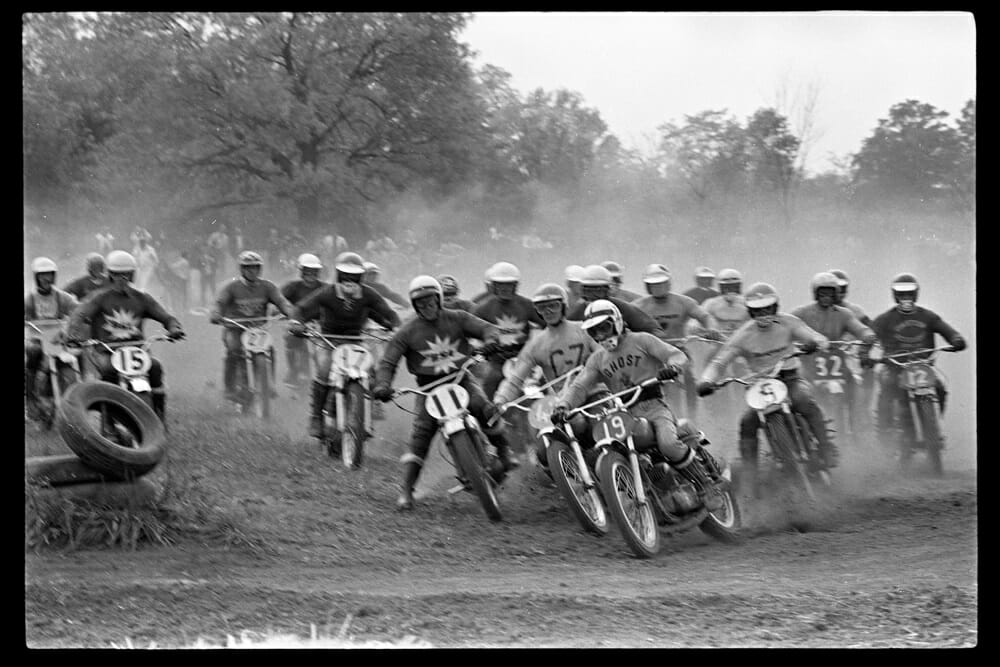 First-moto start with American Sonny DeFeo (19) getting the holeshot on a CZ. DeFeo led briefly before a wheel broke on his bike. Photo: Andy Whipple
First-moto start with American Sonny DeFeo (19) getting the holeshot on a CZ. DeFeo led briefly before a wheel broke on his bike. Photo: Andy Whipple
LaRue’s biggest claim to fame? Believe it or not, the tiny town featured an NFL football franchise in the early 1920s called the Oorang Indians, organized by Walter Lingo, the owner of the Oorang Dog Kennels in LaRue. Lingo organized the team for the sole purpose of advertising his kennel and selling a breed of dog known as the Airedale. Olympian Jim Thorpe was on the team. Considering that LaRue didn’t even have a football field, that was one impressive feat.
That piece of LaRue history is pretty hard to beat, but in terms of motorcycling history there is no doubt that LaRue has one distinction that no other place in the country can boast. On October 11, 1970, LaRue hosted the very first pro motocross race sanctioned by the AMA. It was the opening round of the 1970 Trans-AMA (popularly called the Trans-Am Series). The site was the then newly built motocross track, named Marion County International Raceway, built by brothers Bill and Tom Guthery on 40 acres of farmland just south of LaRue.
It was a big deal in its day. The British factory BSA motocross team featuring John Banks, winner of the 1969 British 500cc Championship and twice runner up in the world championships; Keith Hickman, third in the British BBC Motocross Series; David Nicoll, winner of that year’s BBC Series; Jeff Smith, five-time winner at the Motocross des Nations and Six Days Gold Medal winner, along with team manager Bryan Martin and team mechanic Norman Hanks. AMA staff greeted the team at the Port Columbus Airport and hosted a dinner for the team.
A little late to the game perhaps, but by 1970 the AMA was embracing motocross. It was hard to deny the success of Edison Dye’s Inter-Am Series, which was the first to bring over the established stars of European motocross to compete against American scrambles riders. But as innovative as Dye was, his business practices rubbed some of the manufacturers the wrong way, specifically BSA and Suzuki. Those teams were reportedly asked to pay $15,000 per manufacturer (over $110,000 in today’s dollars) just to enter the Inter-Am Series. And it was with that opening, the AMA’s Russ March decided to work a deal to bring over the BSA and Suzuki teams and hastily assemble the eight-race schedule that ran throughout October and November of 1970.The series was first announced in late July, but the schedule was not released until just barely over two weeks from the first race! So last minute were the final plans, that Cycle News announced the series in its October 6 issue, with the opening round in LaRue happening on October 11th!
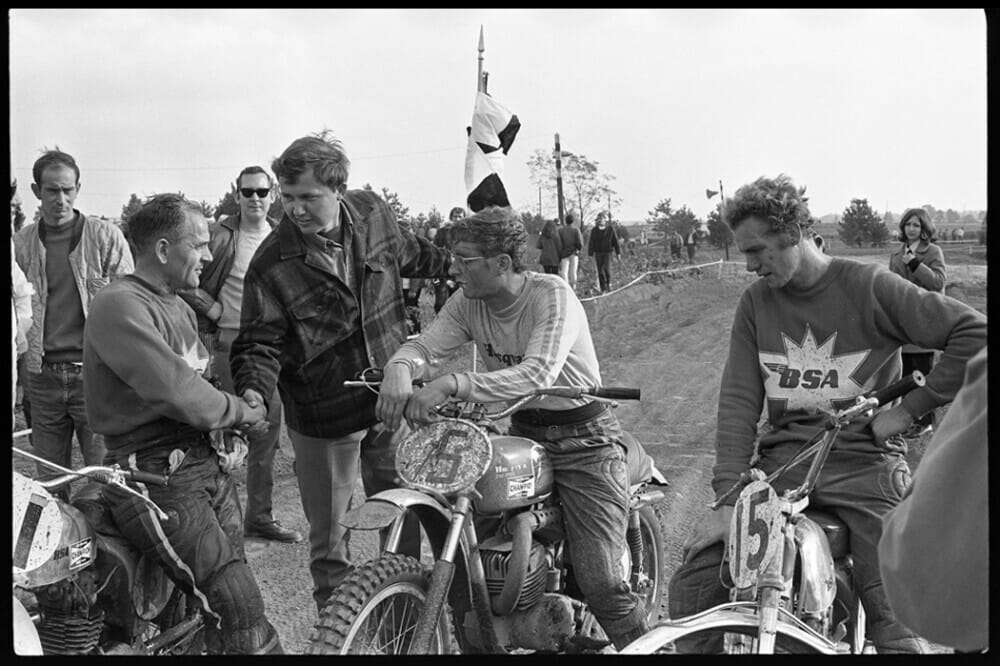 LaRue Trans-AMA winner Jeff Smith is congratulated for winning the overall, while second and third-place finishers Gunnar Lindstrom (5) and Dave Nicoll (15) look on. Nicoll went on to win the 1970 Trans-AMA Championship. Photo: Andy Whipple
LaRue Trans-AMA winner Jeff Smith is congratulated for winning the overall, while second and third-place finishers Gunnar Lindstrom (5) and Dave Nicoll (15) look on. Nicoll went on to win the 1970 Trans-AMA Championship. Photo: Andy Whipple
With many of the established European stars already committed to the Inter-Am, the Trans-AMA would not boast the sheer star power of Dye’s series. The AMA also devised a very odd points structure that heavily favored consistency over winning. As an example: First place awarded 300 points, while second earned 295 and third 290. Half of the events, the riders would be on 250cc bikes and the other half they would race Open-class machinery. A minimum purse of $3000 was to be awarded, with the overall winner at each event earning $800. The series opened in LaRue and then on consecutive weekends travel to Unadilla, New York; Delta Motorsports Park in Toledo, Ohio; Franklin, Georgia; Dallas International Motor Speedway in Lewisville, Texas; Saddleback Park in Orange, California; Carlsbad Raceway (California) and ending on November 29 in Puyallup Raceway Park in Washington.
The AMA was so invested in the AMA Grand National Championships and the stars of that series, the news releases about the Trans-AMA pointed out that that championship was intentionally started after the conclusion of the Grand Nationals, so that the flat track riders might have a chance to compete. In fact, Grand National stars David Aldana and Jim Rice were named as part of BSA’s factory motocross team who would participate in the Trans-AMA Series. At LaRue, Ronnie Rall (CZ), Aldana and Dick Mann, who rode a Husqvarna, were the big name Grand National riders to make the main.
Oddly, the factory Suzuki squad did not show up to the opener in LaRue. It seems that Sylvain Geboers (apparently with the factory’s knowledge) had signed a contract with Dye to race the Inter-Am. Suzuki was not thrilled when they learned of this contract and the factory was on hold while it considered its options. It would later enter the series with Joel Robert leading the way.
The night before the series opener in LaRue, there was a press conference held at the Holiday Inn in nearby Marion. AMA Press Officer Ed Youngblood and Executive Director Russ March gave speeches and BSA racing boss Pete Coleman introduced the factory BSA squad.
Cool and cloudy weather greeted the crowd at LaRue on Sunday. Brad Lackey beat CZ teammate Ron Stockman in the support-race main event. The start of the Trans-Am’s first moto began with a first-turn pileup, in which Husqvarna ace Gunnar Lindstrom was caught up. The crowd was thrilled when American rider Sonny DeFeo briefly led the first moto before breaking a wheel on his machine. Then BSA factory rider Keith Hickman took over and led much of the moto before his bike broke a chain.
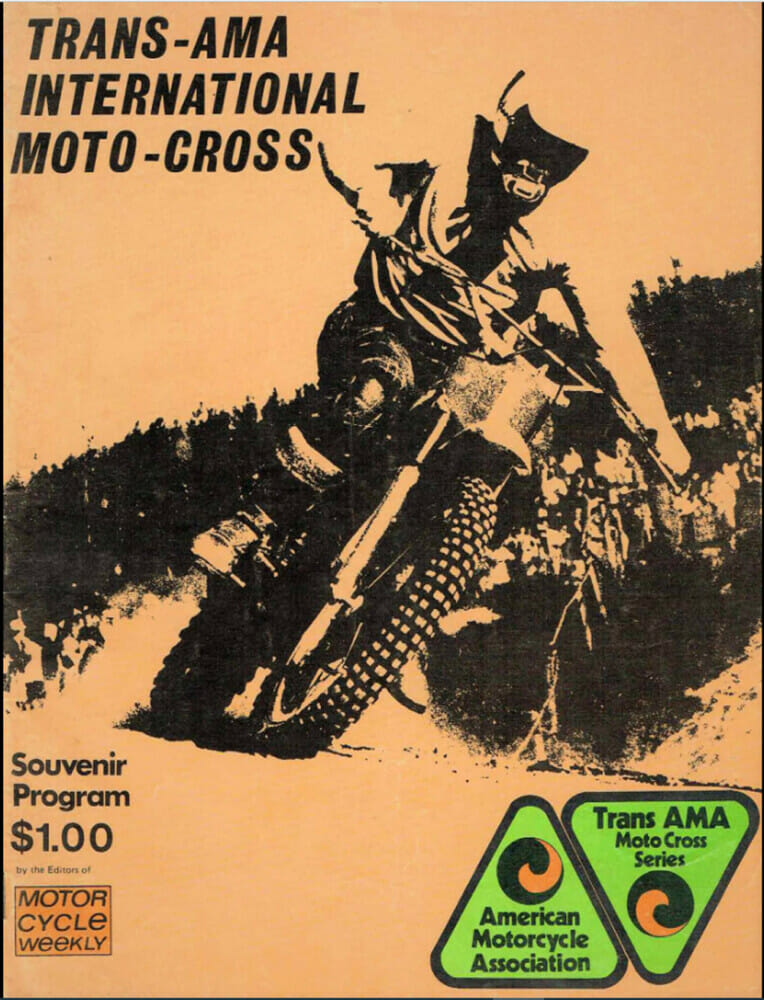 A buck got you what would turn out to be a very valuable program to collectors today.
A buck got you what would turn out to be a very valuable program to collectors today.
After Hickman’s problems, BSA’s Jeff Smith emerged as the leader and held it. But Husky’s Lindstrom recovered from the first turn melee and was flying through the field and quickly making his way up to the leaders. In the closing laps, Lindstrom made it all the way back to pass Smith and apparently won the moto.
Not so fast!
Afterwards, Lindstrom was told he jumped the start, so he was penalized one position, giving the moto victory to Smith. Read into that penalty what you will. Whether or not the decision to penalize Lindstrom had anything to do with BSA being so instrumental in making the series even possible is certainly open to speculation.
Smith led the entire way in the second moto, using his efficient riding style to the max. Some would say Smith’s style was old fashioned, free of cross-ups and wheelies. This time Lindstrom could not make up for another poor start. DeFeo and another American, Bob Thompson, were also leading riders in the second moto, although Cycle News coverage did not list moto finishes but simply the overall.
Smith scored a perfect 1-1 and goes down in history as the first rider to win an AMA-sanctioned professional motocross event. On the podium, Smith was typically understated only saying that he was “Quite tired, but happy to have won the event.”
Lindstrom took second overall, while fellow BSA factory rider Dave Nicoll rounded out the podium finishers. BSA’s John Banks was fourth, giving BSA three out of the top-five finishers. The top American was Bob Thompson who took fifth overall riding an Ossa. Jimmy Weinert was sixth on a CZ. Americans Brian Kenny (Husqvarna), Dick Burleson (Husqvarna), David Aldana (BSA) and Wyman Priddy (Bultaco) rounded out the top 10.
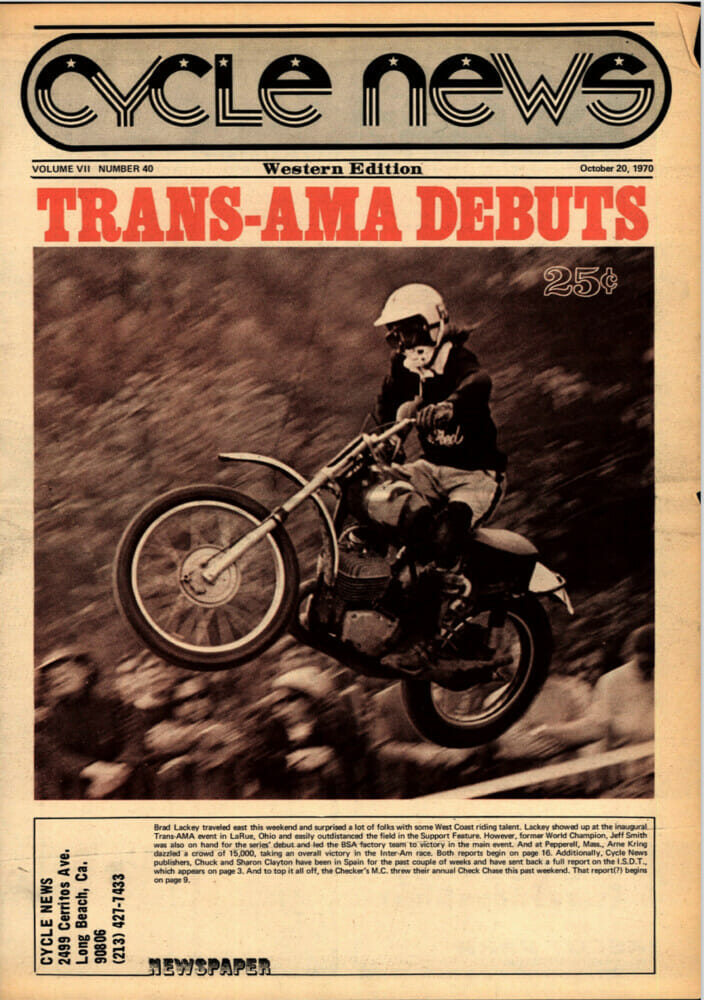 LaRue Trans-AMA support race winner Brad Lackey was pictured on the cover of Cycle News.
LaRue Trans-AMA support race winner Brad Lackey was pictured on the cover of Cycle News.
When Joel Robert showed up on the Suzuki by round three it was all over. He’d go on to close out the season with six straight wins, but Dave Nicoll played it smart and piled up good finishes and points and ended the season as the first Trans-AMA Champion. Two other BSA riders John Banks and Jeff Smith made it a British sweep of the top three in the final standings. Dick Burleson, better known for his vast AMA National Enduro accomplishments, finished fourth in the championship and was the top-placing American, so he is credited as the first AMA Motocross Champion.
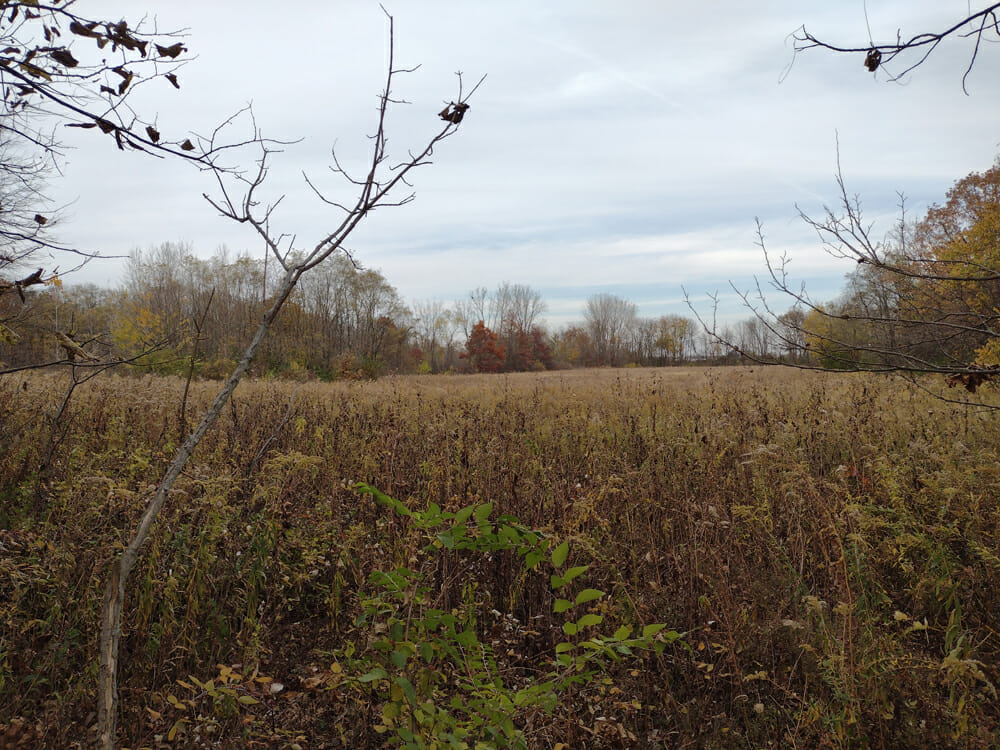 Today, the LaRue track is covered in weeds, and a half-hour slog through the field yielded no remnants of the old motocross track. Photo: Larry Lawrence
Today, the LaRue track is covered in weeds, and a half-hour slog through the field yielded no remnants of the old motocross track. Photo: Larry Lawrence
Today, the LaRue motocross track sits quiet under a layer of overgrown weeds. On a colorful fall day, my buddy Denny Thrush and I rode out to the track, plowed through the chest-high weeds and tried to find any signs of the historic course, but we came away with nothing but clothes covered in cockleburs.
You could drive by the site today and notice the neighboring drag strip, yet never know that at one time, this little, long overgrown track in a little town in the middle of Ohio, once hosted one of the most significant motocross races in America. CN